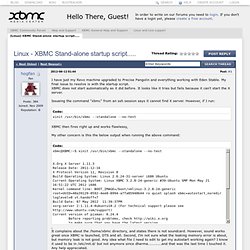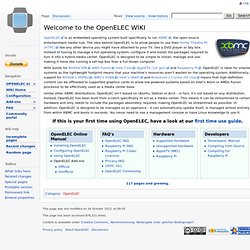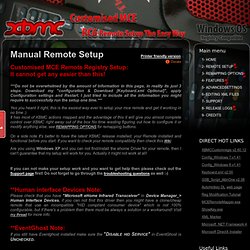

Startup applications - Autostart XBMC at boot. How to configure and connect to gnome x windows desktop via ssh on a Ubuntu Virtual Machine ? - Host Virtual. Stand-alone startup script..... I have just my Revo machine upgraded to Precise Pangolin and everything working with Eden Stable.

My final issue to resolve is with the startup script. XBMC does not start automatically as it did before. It looks like it tries but fails because it can't start the X server. Issueing the command "xbmc" from an ssh session says it cannot find X server. However, if I run: Code: xinit /usr/bin/xbmc --standalone --no-test XBMC then fires right up and works flawlessy, My other concern is this the below output when running the above command: xbmc@XBMC:~$ xinit /usr/bin/xbmc --standalone --no-test , It complains about the /home/xbmc directory, and states there is not soundcard. Welcome to the OpenELEC WIKI. OpenELEC is an embedded operating system built specifically to run XBMC, the open source entertainment media hub.

The idea behind OpenELEC is to allow people to use their Home Theatre PC (HTPC) like any other device you might have attached to your TV, like a DVD player or Sky box. Instead of having to manage a full operating system, configure it and install the packages required to turn it into a hybrid media center, OpenELEC is designed to be simple to install, manage and use, making it more like running a set-top box than a full-blown computer. With builds for NVIDIA ION, AMD Fusion, Intel Core, AppleTV (1st gen) and Raspberry Pi, OpenELEC is ideal for smaller systems as the lightweight footprint means that your machine's resources aren't wasted on the operating system.
Unlike other XBMC distributions, OpenELEC isn't based on Ubuntu, Debian or Arch - in fact, it's not based on any distribution. Instead, OpenELEC has been built from scratch specifically to act as a media center. Custom Registry settings 4 MCE Remotes. On a side note It's better to have the latest XBMC release installed, your Remote installed and functional before you start.

If you want to check your remote compatiblity then check this Wiki Are you using Windows XP and you can not find/install the ehome Driver for your remote, then I can't guarantee that my setup will work for you. Actually it might not work at all! If you can not make your setup work and you want to get help then please check out the Support page first! Do not forget to go through the troubleshooting questions as well :-) Any one new to this and do not know how to open the windows registry Editor, then do this: 1- Click Start & select Run [if you can't see it search for it] or press on your keyboard without the brackets. 2- Type in the field [regedit] without the brackets. 3- Press OK, now the Registry Editor will open.
Check that you have the Registry Path as shown below: NetfliXBMC Brings a Better, Remote-Controlled Netflix to XBMC. Ubuntu and remote desktop. [XBMCbuntu] Logitech Harmony 700 Device/Activity Profile - General Questions - Flirc Forums. Okay, I got it working.
![[XBMCbuntu] Logitech Harmony 700 Device/Activity Profile - General Questions - Flirc Forums](http://cdn.pearltrees.com/s/pic/th/xbmcbuntu-logitech-questions-73408081)
This is something I've tried multiple times before with other IR receivers, but this is the first time it's been 100% successful... so kudos to you guys for Flirc. it seems to be the missing piece to my puzzle. 1) Using my generic Media Center remote, I recorded keystrokes using the terminal command line. (I picked the most useful from this list: ). **Because I'm using a generic MCE remote, I had to record each keystroke twice in the command line to avoid pressing each button twice in XBMC, per this thread: 2) In the Harmony software, I created a device, "Flirc," based on a generic Microsoft MCE Remote (Computer > Media Center PC > Microsoft > MCE Remote). 3) In the device settings, I created a list of custom IR commands (at the bottom of the page); I simply named them after the keystroke they emulate (X, P, Spacebar, etc.). 4) Using the Harmony remote, I learned this set of custom IR commands from the MCE remote. 9) Profit!!
Hope this helps.